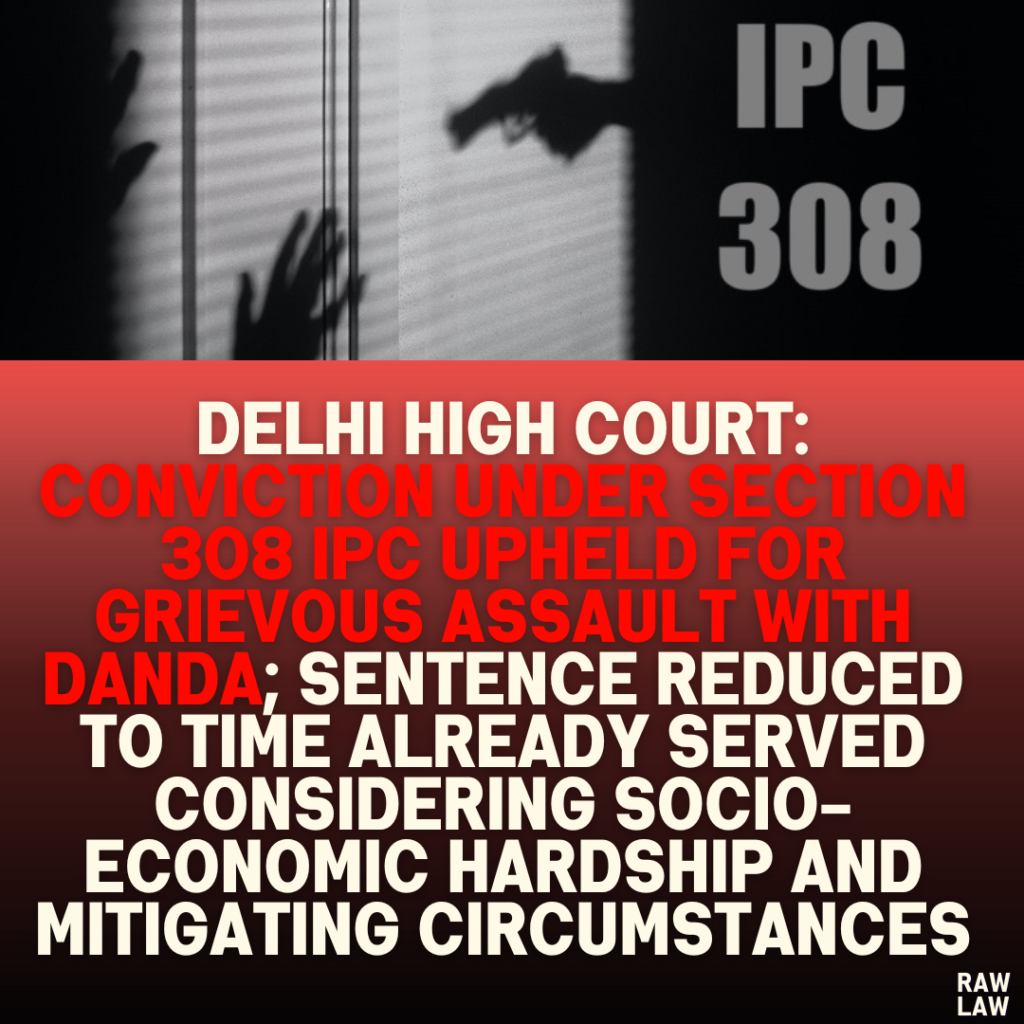Court’s Decision
The Delhi High Court upheld the petitioner’s conviction under Section 308 IPC for causing grievous injuries to the victim with a wooden stick (danda). However, the sentence was modified to the period already undergone by the petitioner (2 years, 3 months, and 27 days) due to mitigating factors such as his socio-economic condition and satisfactory jail conduct.
Facts of the Case
- Incident Description:
- The case arose from an incident where the petitioner allegedly assaulted the victim with a danda, causing grievous injuries to the head, face, and body. The injuries included multiple lacerated wounds and a symphysis fracture of the mandible (lower jaw).
- The victim was initially declared unfit to give a statement, as noted in the Medical Legal Case (MLC).
- Registration of FIR:
- FIR No. 0172/2021 was registered under Section 308 IPC at Shahdara Police Station after evaluating the MLC and recording the victim’s injuries.
- Trial Court Proceedings:
- Charges were framed under Sections 308 and 201 IPC. The petitioner pleaded not guilty and claimed trial.
- The Trial Court convicted the petitioner on August 27, 2024, and sentenced him to 4 years of rigorous imprisonment along with a fine of ₹10,000 (or an additional 4 months of simple imprisonment in case of default).
Issues
- Conviction Justification:
Whether the evidence presented, including eyewitness testimonies and medical reports, justified the petitioner’s conviction under Section 308 IPC. - Sentence Appropriateness:
Whether the 4-year sentence imposed by the Trial Court was excessive, given the petitioner’s socio-economic condition and mitigating circumstances.
Petitioner’s Arguments
- The petitioner did not dispute the conviction but sought modification of the sentence.
- Key points raised:
- The petitioner was the sole breadwinner for his family, comprising an elderly father, a wife, and three young children aged 4, 6, and 8.
- He was a rickshaw puller and belonged to a poor socio-economic background.
- He had already served over two years in incarceration with a satisfactory jail record.
Respondent’s Arguments
- The prosecution emphasized the grievous and life-threatening nature of the injuries inflicted by the petitioner, asserting that the conviction under Section 308 IPC was legally sound.
- Eyewitness accounts, medical evidence, and corroborative testimonies established the petitioner’s guilt beyond a reasonable doubt.
Analysis of the Law
Section 308 IPC criminalizes acts committed with the intention or knowledge to cause injuries that, if resulting in death, would amount to culpable homicide.
- Key Legal Parameters:
The court noted that conviction under Section 308 IPC requires:- Proof of intention or knowledge to commit an act leading to culpable homicide.
- Assessment of the circumstances, nature of injuries, the weapon used, and the area of the body where injuries were inflicted.
- Medical Evidence:
The MLC established grievous injuries, including multiple lacerations, a mandible fracture, and other wounds. These were inflicted on vital body parts (head and face), indicating intent or knowledge to cause serious harm. - Eyewitness Testimonies:
The victim (PW3) and his wife (PW1) identified the petitioner as the assailant. Their statements were consistent and corroborated by medical and other evidence.
Precedent Analysis
The court referred to Aas Mohd. @ Ashu v. State (2021), which held that non-recovery of the weapon of offence does not undermine the prosecution’s case if other evidence establishes guilt. Applying this precedent, the court dismissed the petitioner’s argument about the absence of weapon recovery.
Court’s Reasoning
- Evidence Corroboration:
- The victim’s testimony, medical records, and corroboration by other witnesses (e.g., his wife and police officials) established the petitioner’s guilt.
- The injuries inflicted were life-threatening and serious, warranting conviction under Section 308 IPC.
- No Evidence of False Implication:
- No material evidence suggested false implication or enmity between the petitioner and the victim.
- Mitigating Factors for Sentencing:
- The petitioner’s socio-economic background, satisfactory jail conduct, and responsibilities toward his family warranted a reduction in sentence.
Conclusion
- Conviction: The court upheld the Trial Court’s conviction under Section 308 IPC.
- Sentence Modification: In light of the petitioner’s circumstances and satisfactory jail record, the sentence was reduced to the period already undergone (2 years, 3 months, and 27 days).
- Bail bonds were canceled, and the surety was discharged.
Implications
- Justice with Compassion:
The judgment reflects a balanced approach, upholding the law while considering the socio-economic realities of the convicted individual. - Sentencing Principles:
It reinforces that sentencing should factor in mitigating circumstances, including the convict’s background, responsibilities, and post-conviction conduct. - Legal Precedents:
The application of prior judgments (e.g., Aas Mohd.) strengthens jurisprudence on evidence sufficiency despite the absence of weapon recovery.
This judgment underscores the judiciary’s commitment to fair justice while upholding the principles of criminal law.




Pingback: Delhi High Court Highlights Challenges in Cybercrime Data Requests, Emphasizes Expedited Implementation of SAHYOG Portal: "Efficient Data Access is Crucial for Effective Law Enforcement Coordination" - Raw Law